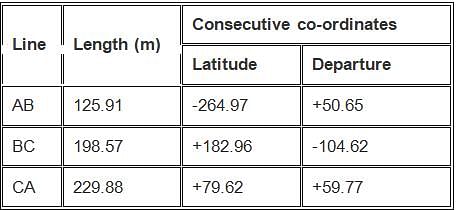Civil Engineering (CE) Exam > Civil Engineering (CE) Tests > Geomatics Engineering (Surveying) > Test: Balancing the Traverse - Civil Engineering (CE) MCQ
Test: Balancing the Traverse - Civil Engineering (CE) MCQ
Test Description
10 Questions MCQ Test Geomatics Engineering (Surveying) - Test: Balancing the Traverse
Test: Balancing the Traverse for Civil Engineering (CE) 2025 is part of Geomatics Engineering (Surveying) preparation. The Test: Balancing the Traverse questions and answers have been
prepared according to the Civil Engineering (CE) exam syllabus.The Test: Balancing the Traverse MCQs are made for Civil Engineering (CE) 2025 Exam. Find important
definitions, questions, notes, meanings, examples, exercises, MCQs and online tests for Test: Balancing the Traverse below.
Solutions of Test: Balancing the Traverse questions in English are available as part of our Geomatics Engineering (Surveying) for Civil Engineering (CE) & Test: Balancing the Traverse solutions in
Hindi for Geomatics Engineering (Surveying) course. Download more important topics, notes, lectures and mock
test series for Civil Engineering (CE) Exam by signing up for free. Attempt Test: Balancing the Traverse | 10 questions in 30 minutes | Mock test for Civil Engineering (CE) preparation | Free important questions MCQ to study Geomatics Engineering (Surveying) for Civil Engineering (CE) Exam | Download free PDF with solutions
Test: Balancing the Traverse - Question 1
Which of the following method doesn’t require the calculation of latitudes and departures?
Detailed Solution for Test: Balancing the Traverse - Question 1
Test: Balancing the Traverse - Question 2
Which of the following implies the correct set of methods employed for balancing the traverse?
Detailed Solution for Test: Balancing the Traverse - Question 2
Detailed Solution for Test: Balancing the Traverse - Question 3
Detailed Solution for Test: Balancing the Traverse - Question 4
Detailed Solution for Test: Balancing the Traverse - Question 5
Test: Balancing the Traverse - Question 6
In order to complete traverse computations, which of the following steps is to be carried out first?
Detailed Solution for Test: Balancing the Traverse - Question 6
Test: Balancing the Traverse - Question 7
Among the following, the most commonly used method of balancing a traverse is _______
Detailed Solution for Test: Balancing the Traverse - Question 7
Test: Balancing the Traverse - Question 8
Independent co-ordinates can be calculated by using _______
Detailed Solution for Test: Balancing the Traverse - Question 8
Test: Balancing the Traverse - Question 9
Using transit method, calculate the correction for latitude of BC.

Detailed Solution for Test: Balancing the Traverse - Question 9
Test: Balancing the Traverse - Question 10
According to Bowditch's rule correction to latitude or departure of any side is equal to -
|
19 videos|32 docs|35 tests
|
Information about Test: Balancing the Traverse Page
In this test you can find the Exam questions for Test: Balancing the Traverse solved & explained in the simplest way possible.
Besides giving Questions and answers for Test: Balancing the Traverse, EduRev gives you an ample number of Online tests for practice


















